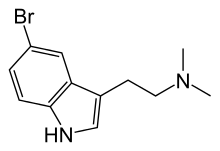 | |
| Legal status | |
|---|---|
| Legal status |
|
| Identifiers | |
IUPAC name
| |
| CAS Number | |
| PubChem CID | |
| ChemSpider | |
| UNII | |
| CompTox Dashboard (EPA) | |
| Chemical and physical data | |
| Formula | C12H15BrN2 |
| Molar mass | 267.170 g·mol−1 |
| 3D model (JSmol) | |
SMILES
| |
| |
5-Bromo-DMT (5-bromo-N,N-dimethyltryptamine) is a psychedelic brominated indole alkaloid found in the sponges Smenospongia aurea and Smenospongia echina, as well as in Verongula rigida (0.00142% dry weight) alongside 5,6-Dibromo-DMT (0.35% dry weight) and seven other alkaloids.[1][2][3][4] It is the 5-bromo derivative of DMT, a psychedelic found in many plants and animals.
5-Bromo-DMT has a pEC50 value of 5.51 for the 5-HT2A receptor.[5]
Animal studies on 5-Bromo-DMT showed that it produces effects suggestive of sedative and antidepressant activity and caused significant reduction of locomotor activity in the rodent FST model.[6]
5-Bromo-DMT was reported to be psychoactive at 20–50 mg via vaporization with mild psychedelic-like activity.[7]
Legality
5-Bromo-DMT is specifically listed as a controlled drug in Singapore.[8]
Related compounds
- 5-Chloro-αMT
- 5-Fluoro-AMT
- 5-Fluoro-DMT
- Convolutindole A
- Desformylflustrabromine
- Plakohypaphorine
References
- ^ US 2012029010, Hamann MT, Kochanowska AJ, El-Alfy A, Matsumoto RR, Boujos A, "Method to use compositions having antidepressant anxiolytic and other neurological activity and compositions of matter", published 2 February 2012
- ^ Longeon A, Copp BR, Quévrain E, Roué M, Kientz B, Cresteil T, et al. (May 2011). "Bioactive indole derivatives from the South Pacific marine sponges Rhopaloeides odorabile and Hyrtios sp". Marine Drugs. 9 (5): 879–88. doi:10.3390/md9050879. PMC 3111189. PMID 21673896.
- ^ Hu JF, Schetz JA, Kelly M, Peng JN, Ang KK, Flotow H, et al. (April 2002). "New antiinfective and human 5-HT2 receptor binding natural and semisynthetic compounds from the Jamaican sponge Smenospongia aurea". Journal of Natural Products. 65 (4): 476–80. doi:10.1021/np010471e. PMID 11975483.
- ^ Djura P, Stierle DB, Sullivan B, Faulkner DJ, Arnold EV, Clardy J (April 1980). "Some metabolites of the marine sponges Smenospongia aurea and Smenospongia (.ident.Polyfibrospongia) echina". Journal of Organic Chemistry. 45 (8): 1435–1441. doi:10.1021/jo01296a019.
- ^ Matzdorf T (10 March 2015). 5-Carboxamidotryptamin-Derivate als Liganden für 5-HT7- und 5-HT2A-Rezeptoren: Synthese und In-vitro-Pharmakologie (Ph.D. thesis) (in German). Universität Regensburg. Retrieved 21 October 2015.
- ^ Kochanowska AJ, Rao KV, Childress S, El-Alfy A, Matsumoto RR, Kelly M, et al. (February 2008). "Secondary metabolites from three Florida sponges with antidepressant activity". Journal of Natural Products. 71 (2): 186–9. doi:10.1021/np070371u. PMC 4918908. PMID 18217716.
- ^ Morris H, Wallach J (26 March 2013). "Sea DMT: God Molecule or Barnacle Repellent?". Vice. Retrieved 21 October 2015.
- ^ "Misuse of Drugs Act - Singapore Statutes Online". sso.agc.gov.sg.